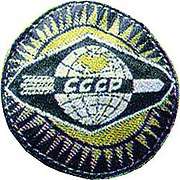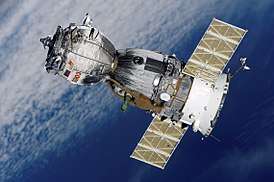Soyuz 18
Soyuz 18 (Russian: Союз 18, Union 18) was a 1975 Soviet crewed mission to Salyut 4, the second and final crew to man the space station. Pyotr Klimuk and Vitali Sevastyanov set a new Soviet space endurance record of 63 days and the mark for most people in space simultaneously (seven) was tied during the mission.
| COSPAR ID | 1975-044A |
|---|---|
| SATCAT no. | 7818 |
| Mission duration | 62 days, 23 hours, 20 minutes, 8 seconds |
| Orbits completed | 993 |
| Spacecraft properties | |
| Spacecraft type | Soyuz 7K-T |
| Manufacturer | NPO Energia |
| Launch mass | 6,825 kilograms (15,047 lb) |
| Crew | |
| Crew size | 2 |
| Members | Pyotr Klimuk Vitali Sevastyanov |
| Callsign | Кавказ (Kavkaz - "Caucasus") |
| Start of mission | |
| Launch date | May 24, 1975, 14:58:10 UTC |
| Rocket | Soyuz |
| Launch site | Baikonur 1/5[1] |
| End of mission | |
| Landing date | July 26, 1975, 14:18:18 UTC |
| Landing site | 51°N 68°E |
| Orbital parameters | |
| Reference system | Geocentric |
| Regime | Low Earth |
| Perigee altitude | 186 kilometres (116 mi) |
| Apogee altitude | 230 kilometres (140 mi) |
| Inclination | 51.7 degrees |
| Period | 88.6 minutes |
| Docking with Salyut 4 | |
 Soyuz programme (Crewed missions) | |
Crew
| Position | Cosmonaut | |
|---|---|---|
| Commander | Pyotr Klimuk Second spaceflight | |
| Flight Engineer | Vitali Sevastyanov Second and last spaceflight | |
Mission parameters
- Mass: 6,825 kg (15,047 lb)
- Perigee: 186 km (116 mi)
- Apogee: 230 km (140 mi)
- Inclination: 51.7°
- Period: 88.6 minutes
Mission highlights
The Soyuz 18 crew were the back-up crew for the failed Soyuz 18a mission, carried out that mission's objectives, and continued the work of the previous Soyuz 17 crew.[2][3] Klimuk and Sevastyanov were launched into space on 24 May 1975 and docked with Salyut 4 two days later. The crew quickly set to performing experiments and fixing or replacing equipment. A spectrometer was repaired, a gas analyzer was replaced, and a pumping condenser in the water regeneration system was switched with a hand pump.[2]
On 29 and 30 May, biological and medical experiments were performed and the Oasis garden was started. Studies of the stars, planets, Earth and its atmosphere were started on 2 and 3 June. Some 2,000 photographs of the Earth and 600 of the sun were reported taken.[2]
More medical experiments were performed in June, and attempts were made to grow plants, including onions. Experiments were carried out on insects, and experiments on varying the work schedule were carried out.[2]
Extensive medical experiments were carried out on 23 June, as the crew surpassed the Soviet space endurance record of 29 days, set by Soyuz 17, the Salyut's previous crew.[2] The all-time record was held then by the Skylab 4 crew at 84 days.
On 3 July, it was announced that the mission would last beyond the upcoming Apollo-Soyuz Test Project (ASTP). To avoid any conflict of resources, the Soyuz 18 crew was controlled from the old Crimean Control Center, while the ASTP Soyuz 19 mission would be controlled from the Kaliningrad Control Center. The Crimean center had not been used since the Soyuz 12 flight.[2] This was the first time the Soviets had to control two unrelated space missions.[3]
The ASTP crews were launched 15 and 16 July, and the Soyuz 18 crew communicated with the Soyuz 19 crew on two brief occasions.[2] The total of seven people in space tied the record set by the Soyuz 6, Soyuz 7 and Soyuz 8 flights of 1969. Once the American ASTP crew landed 24 July, the Soviets had a near six-year monopoly on crewed space flights until the launch of the first space shuttle, STS 1, on 12 April 1981.
The Salyut living conditions were starting to degrade by July, with the environmental control system failing, windows fogged over and green mold growing on the station walls. The crew donned exercise suits and increased their exercise period to over two hours a day, and on 18 July began to prepare the station for uncrewed flight. The Soyuz craft was activated on 24 July and the crew returned to earth two days later.[2]
The cosmonauts exited the capsule under their own power, but it was two days before Klimuk could take a 10-minute walk, and a week before he made a full recovery.[2]
References
- "Baikonur LC1". Encyclopedia Astronautica. Archived from the original on 2009-04-15. Retrieved 2009-03-04.
- Newkirk, Dennis (1990). Almanac of Soviet Manned Space Flight. Houston, Texas: Gulf Publishing Company. ISBN 0-87201-848-2.
- Clark, Phillip (1988). The Soviet Manned Space Program. New York: Orion Books, a division of Crown Publishers, Inc. ISBN 0-517-56954-X.
